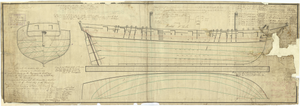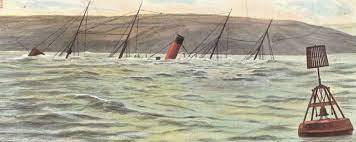The Manacles reef is a designated area of outstanding natural beauty at the south-westerly corner of Falmouth Bay, the third largest natural harbour in the World. The name is derived from the Cornish words “maen eglos” meaning “church stones” as it is in clear site of St Keverne church. The name may also refer to the ring of tombstone-shaped teeth of greystone slate that rise sharply out of the sea or more often sit just below the surface. Understandably, a popular summer destination for boating, fishing and diving but not a place you want to be on a dark and stormy night.
The song highlights three of the best known wrecks amongst many and demonstrates why it was necessary to install a cardinal buoy mounted with a bell to mark these treacherous rocks.
HMS Primrose
Built in Fowey in 1807 by Thomas Nickells, HMS Primrose set sail in January 1809 to join a convoy heading for the Spanish peninsula war. However, they were enveloped by a blizzard and at 5am on the 22nd January, they struck Minstrel Rock. Six men from Porthoustock rowed out in a rescue attempt but there were no survivors with the exception of a drummer boy found clinging to a rock. Those lost were interred in the churchyard at St Keverne.

The John
On a fine Spring afternoon in May 1855, a barque called The John set off from Plymouth with 263 passengers from Devon and Cornwall, families bound for a new life in Canada. Whilst crossing Falmouth Bay in the evening, the first mate informed Captain Edward Rawle that the Lizard lighthouse could not be seen suggesting that they were too far in. The Captain chose to ignore this and shortly after, The John foundered on the Eastern Rocks. After a bungled attempt by the crew to launch a lifeboat, Rawle ordered no more action and to wait until rescue came in the morning. But he has misjudged the tide and as the seas broke over the deck, he and his crew climbed into the rigging and watched as 196 men, women and children were taken below. When boats from Coverack and Porthoustock reached The John in the morning, the first aboard were the crew – not one member of the crew was lost. Captain Rawle was initially found guilty of manslaughter but was acquitted later and was soon back at sea, working for the family shipping company.
Further information is available at;
The Mohegan
Bound for New York, the Mohegan sailed from Tilbury Docks at 2:30pm on 13 October 1898, under the command of the 42-year-old Captain Richard Griffith. She carried 57 passengers, 97 crew, seven cattlemen, and 1,286 tons of spirits, beer, and antimony,
Reaching her maximum speed as she sailed down the English Channel, she kept close to the coast as she passed Cornwall but took the wrong bearing. This was noticed by some of the officers and crew. They had noticed that the Eddystone Lighthouse was too far away and the coast too close. She headed towards The Lizard without slowing from 13 knots. This was noticed by the Coverack coastguard, which attempted to signal to her with warning rockets. The Mohegan either was unaware or took no notice, and maintained her course. James Hill, coxswain of the Porthoustock lifeboat, saw the ship, lights ablaze, heading at full speed towards the Manacle Rocks. With a cry of ‘She’s coming right in!’ he called his crew. The crew were finally alerted now to the danger, whether by the signals from shore or by the ‘old Manacle bell’ from the buoy, and the engines were stopped at 6:50 PM, but too late. The ship rolled and sank 12 minutes after hitting the rocks, with the loss of 106 lives. Captain Griffith, Assistant Engineer William Kinley and all of the officers went down with the ship. Only her funnel and four masts remained above water. Most of the recovered bodies of the drowned were buried in a mass grave in St Keverne churchyard, which was given a memorial stained glass window by the Atlantic Transport Line.




